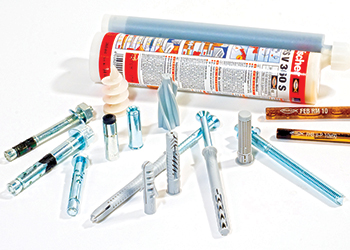Fischer strengthens its presence in the region
01 September 2015
Fischer Fixing, a specialist in fixings and installation systems, has expanded its operations in the UAE to enhance its services to the region by opening a new office in Abu Dhabi.
The Germany-based company has been serving the Middle East for decades. “In order to serve our customers better, Fischer decided to open its own subsidiary Fischer FZE in 2006 in Dubai as its regional headquarters,” says Kusum Rawat, marketing manager, Fischer Fixing.
The company also has its central warehouse for the Middle East in Dubai. Within the Middle East, Fischer has a strong presence in Qatar, Kuwait, Saudi Arabia, Oman, Bahrain and Abu Dhabi.
Founded in 1948, Fischer is one of the most innovative groups of companies in the world, with 43 subsidiaries in 32 countries. It has earned a reputation for designing, engineering and building tough industrial machinery.
The company’s expert services include providing safe, economic fixings and connectors around the world for professionals and craftsmen. Its innovative fixing products include special rail fixings, facade systems, installation systems for mechanical, electrical and plumbing (MEP) supports, fire-stopping products, solar fixing systems, and mechanical and chemical anchors.
Fischer is at the forefront of chemical anchor development, according to Rawat. “It has taken chemical anchoring into areas where it was believed it had no place,” she says. “The use of chemical anchors and chemical mortars in the cracked tensile zones of concrete was for many years believed to be impossible. The Fischer group of companies pioneered this technology and today chemical fixings can be done into cracked concrete with absolute safety and exceptionally high loading.”
Tracing the history of chemical anchors, she says these fixings were invented in 1960s in Germany and first came into prominence in the construction of the Olympic Stadium for the 1972 Munich Summer Olympic Games.
 |
Chemical anchors from Fischer. |
“There was a requirement for fixings into concrete that could withstand very heavy loads using small anchor-anchor spacing and edge distances – something not achieved by normal steel expansion anchors. From those beginnings, technology has developed dramatically to the extent that chemical anchoring has become the norm rather than the exception,” she explains.
Chemical anchoring can be divided into two groups. The first is the original concept, whereby a chemical resin and hardening agent are placed together into a glass capsule filled with quartz aggregate. A hole is drilled to diameter, the dust cleaned out and a threaded stud with a chisel point on the end is drilled into the capsule, breaking and mixing the contents and bonding the stud to the hole.
The second group was developed in the mid-1980s, which has enhanced chemical fixing with the introduction of a two-component chemical mortar. “Contained in a plastic cartridge and dispensed through a mixing nozzle by means of an applicator or injection gun, this development enabled chemical anchoring technology to become much more versatile and user-friendly. It could now be utilised into a wider range of building materials unlike its predecessor. The ease of use and practicality of the chemical injection system for applications in masonry, hollow blocks, cavity floors and so forth has made it the fixing method of choice,” she points out.
As the market has grown, there has been a proliferation of chemical anchors and chemical mortars with products ranging across the quality and performance spectrums. Consumers, however, have access to information that can guide them to select the most appropriate products by accessing product approvals from the world’s leading approval authority, the Eota (European Organisation for Technical Approvals). Products with European Technical Approvals (ETAs) under the supervision of Eota guarantee performance levels with the knowledge that safety and security cannot be compromised, she adds.
Various types of chemicals have been used in the manufacture of chemical anchors. “Originally a polyester resin with styrene as the hardening agent was the most predominant,” Rawat explains. “However, over time polyester was found to be carcinogenic and subject to saponification when exposed to moisture, resulting in a loss of approximately 40 per cent in its bonding strength. Furthermore, styrene is a known carcinogenic. Polyesters should, therefore, only be used for interior applications. Fischer does not support the use of polyesters in critical areas where accidents can occur and people can get injured.”
After technological improvements brought about epoxy acrylates and hybrid polyesters (polyesters with an organic compound), the next development in chemical anchoring was vinylesters (also including hybrid vinylesters) and finally, the premium and most secure chemical anchoring available today comprises of pure epoxy.
Some of the prestigious projects the company has supplied its fixings to in the Middle East include Al Maryah Island (previously known as Sowwah island) and Etihad Towers in Abu Dhabi; Dubai monorail and Burj Al Arab Hotel in Dubai; King Saud University and Princess Nora Bint Abdulrahman University in Saudi Arabia; and Wakrah stadium, Qatar Islamic Tower office, Mall of Qatar, Qatar Foundation car-park site, Qatar Rail, Light Rail Transit (LRT), Abraj Quarters at The Pearl, Banana Island, Doha Festival City, Qatar Petroleum District, the Sheraton hotel renovation, Msheireb Downtown Doha Phase Two and Hamad Medical City project.



